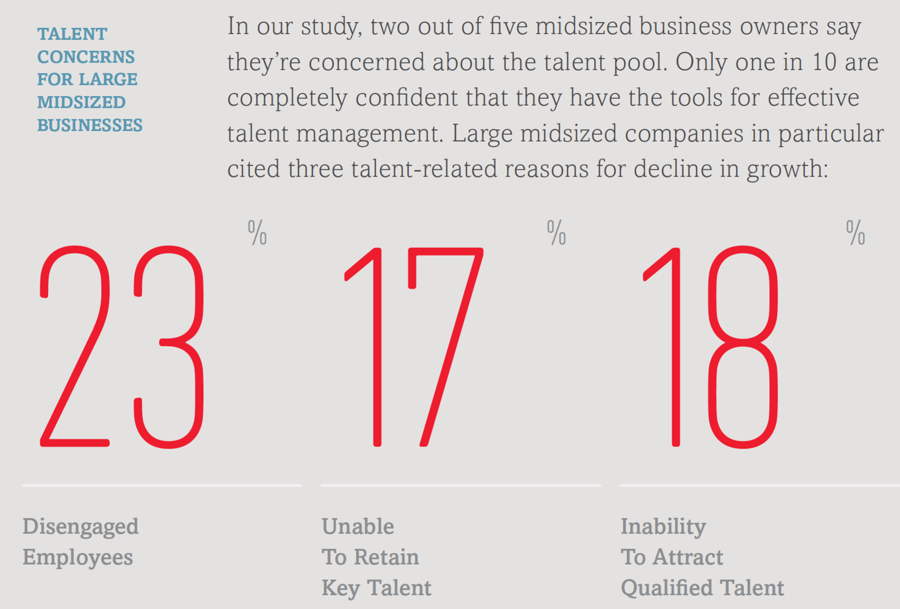
3 min read
A study finds that midsized businesses struggle with a variety of personnel challenges that seem to emerge right around the 50-employee number.
By Bev Attfield
Most of Jostle’s customers can be described as midsized businesses: those with 50-1,000 employees. We’ve seen first hand that these companies invariably hit a communications wall where what worked when they were small businesses suddenly fails.
So it was interesting to read through a recent report from the ADP Research Institute that focuses on midsized companies. It looked at what’s working and what the companies surveyed were worried about. In particular, there were a few things. Regulations and compliance ranked high on the anxiety list, but when asked about growth in particular, these issues came to the forefront:
“Two out of five midsized business owners say they’re concerned about the talent pool.
Only one in 10 are completely confident they have the tools for effective talent management.
Large midsized companies in particular cited three talent-related reasons for decline in growth: disengaged employees, unable to retain key talent, and the inability to attract qualified talent.”
 http://www.adp.com/solutions/midsized-business/resources/article.aspx?id=29A5B03C-31C3-4359-BD75-AB0BF7BC351A
http://www.adp.com/solutions/midsized-business/resources/article.aspx?id=29A5B03C-31C3-4359-BD75-AB0BF7BC351A
Robert Sher, Midsized Business Consultant, Forbes, commented in the report:
“Midsized businesses with the practices of a startup cannot thrive. Even firms with solid products and services often feel they can continue growing without much change in process because of past successes.”
This speaks to the fact that when businesses grow past that 50-employee milestone, things change. When a company transitions from small to midsized, communication is one of the first things that fails to scale. This can be the primary source of those growth problems – engagement, hiring qualified people, and retaining top talent. It’s not just the lack of processes, but the lack of good communication habits and capabilities that start to drag down an organization’s culture and engagement.
Poor communication has a cascading effect on efficiency and productivity, and also the emotional well-being of the organization. People feel frustrated, and increasingly irrelevant, as more of the work of the company becomes invisible to them. Things change, and they are out of the loop. They no longer feel connected to the mission. Cascading further, it becomes very hard to hire into this kind of anxious environment. Morale begins to decline. People are still working hard, but what worked before doesn’t seem to achieve the same kind of results anymore.
Fast growing companies hit three important barriers to great communication:
It’s at that milestone of around 50 employees when most companies start to look for their first employee communications platform, their first intranet. A great intranet solves people problems by making it easy to communicate in all the ways an organization needs – peer to peer, within and amongst teams, and from leadership. A great intranet helps to build and sustain a vibrant culture as the company grows, can help employees feel like they belong, and helps sustain clarity and transparency across the organization so that people know what’s going on and what’s important right now. Intranets connect people across geography, and organizational structure. Every organization needs a place to share resources and esprit de corps.
It’s important for rapidly growing companies to plan for this transition from small to midsized before they hit the 40-50 employee mark. A proactive approach can prevent a decline in employee engagement and reinforce strong culture, communications, and employee engagement when it’s most needed.
The catch is that these growing companies rarely have the IT resources to design, build, deploy, and maintain an intranet based on a platform. Those resources have more strategic, mission critical work to do. They need something that they can buy, and it will just work. We think we can help.
Read more by
Bev Attfield
Jostle’s employee success platform is where everyone connects, communicates, and celebrates at work. Find out more at jostle.me. © 2009–2024 Jostle Corporation. All rights reserved.